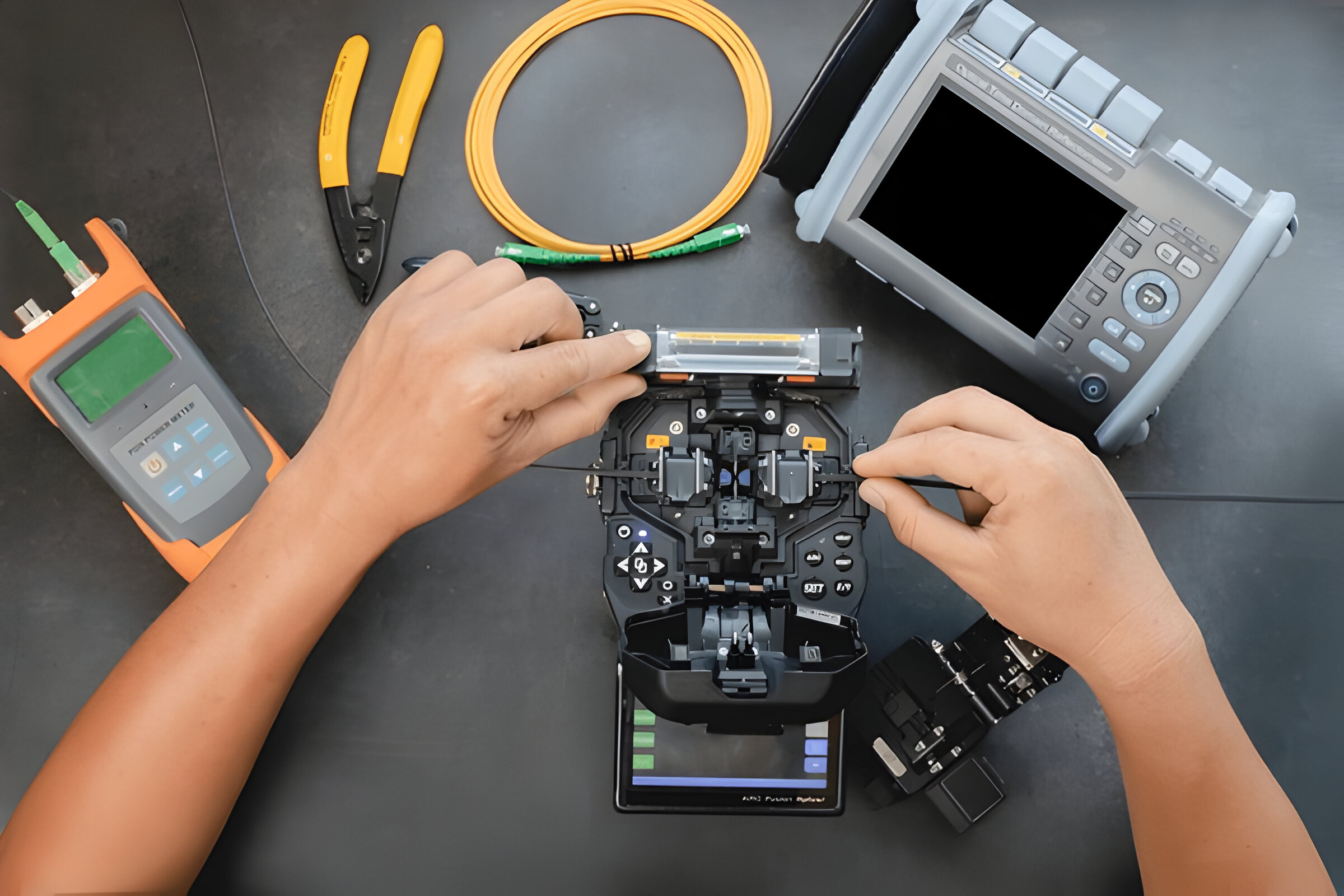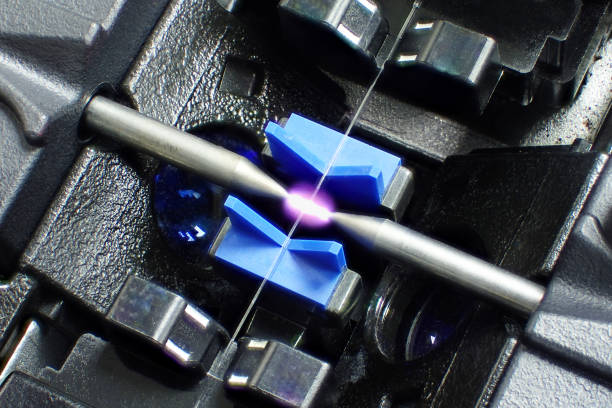Envision a digital landscape where information travels at the speed of light, linking urban centers, corporate hubs, and residential areas with unwavering efficiency. Fiber optic cable splicing stands as the foundational skill enabling this vision, expertly uniting fiber strands to maintain flawless signal transmission. Essential for mending faults or scaling networks, splicing underpins the backbone of contemporary communications. In this comprehensive guide, we delve into the intricacies of fiber optic splicing—encompassing methodologies, instruments, and best practices—while highlighting Dekam Fiber’s state-of-the-art offerings that facilitate durable networks. Join us as we uncover the nuances of fiber splicing and position Dekam Fiber as your go-to ally in connectivity.
Understanding Fiber Optic Cable Splicing
Fiber optic splicing represents the technique of durably linking two optical fibers to establish an unbroken conduit for data, crucial in contexts such as infrastructure repairs or system expansions. Distinct from connectors that provide reversible junctions with elevated attenuation levels (typically around 0.25 dB), splicing yields superior conductivity—frequently below 0.08 dB per joint—rendering it indispensable for extended telecommunications or enterprise data environments. Consider a 40 km infrastructure where splices preserve transmission quality within a 15 dB threshold for 25G operations.
The predominant approaches include fusion splicing, employing thermal energy to integrate fiber tips, and mechanical splicing, utilizing a structural holder to position fibers. Fusion splicing excels in efficiency (e.g., 0.03 dB attenuation) for enduring setups, whereas mechanical splicing (e.g., 0.15 dB attenuation) caters to expedient, interim resolutions. Dekam Fiber’s versatile splicing portfolios accommodate both, offering adaptability for endeavors ranging from 500m home fiber installations to 80 km intercity conduits.

As we approach 2025, the fiber optics sector is evolving rapidly, driven by demands for ultra-high bandwidth and sustainable practices. Trends indicate a surge in AI-enhanced splicing devices that automate alignment for greater accuracy, alongside bend-resistant fibers that minimize losses in compact deployments. According to industry forecasts, the global optical fiber splice market is projected to expand at a 14.62% CAGR from 2026 to 2033, reaching $18.12 billion, fueled by 5G rollouts and FTTH proliferation. Dekam Fiber stays ahead by incorporating these advancements, ensuring our solutions align with emerging needs like green optics and AI integration for smarter networks.
Historically, fiber splicing has transitioned from rudimentary mechanical methods in the 1970s to sophisticated fusion technologies today, reducing average splice losses from 0.5 dB to under 0.05 dB. This evolution supports applications in diverse fields: telecommunications for backbone links, data centers for low-latency interconnects, and even medical imaging for precise signal relay. In practical terms, a typical urban FTTH project might involve dozens of splices per kilometer, each requiring meticulous execution to avoid cumulative signal degradation that could halve effective bandwidth.
Dekam Fiber’s approach emphasizes user-friendly designs, such as pre-calibrated splicers that reduce setup time by 30%, making splicing accessible even for field technicians with moderate experience. By understanding these fundamentals, network engineers can select optimal methods, balancing factors like installation speed, environmental resilience, and long-term cost savings.
Why Choose Fusion Splicing for Your Network?
Fusion splicing emerges as a top-tier option due to its exceptional dependability and minimal signal interference. Through an electrical discharge heating fiber extremities to about 1800°C, it forges a resilient union—imagine 0.04 dB attenuation across a 30 km segment with four junctions. This exactitude proves vital for bandwidth-intensive setups, including 100G urban systems, where aggregate attenuation must remain under 25 dB. Fusion joints also thrive in adverse settings, featuring IP67-rated housings that guard against moisture, particulates, or thermal extremes.
In contrast to mechanical splicing, prone to gradual deterioration (e.g., 0.2 dB increase annually), fusion splicing guarantees endurance spanning decades—ideal for vital systems like healthcare facilities or international cables. Recent innovations, such as AI-driven splicers that predict and adjust for fiber imperfections, further enhance outcomes, with some models achieving 99.9% first-pass success rates.
From a performance standpoint, fusion splicing supports higher data rates by preserving signal integrity over longer distances. For instance, in a 150 km long-haul network, fusion’s low-loss characteristics can extend reach without amplifiers, cutting operational expenses by up to 20%. Environmental resilience is another boon; splices encased in Dekam Fiber’s rugged closures withstand temperatures from -40°C to 85°C, outperforming mechanical alternatives that may falter in vibrations or humidity.

Industry trends in 2025 underscore fusion’s dominance, with the fusion splicer market anticipated to grow substantially, valued at millions in emerging segments like 5G backhaul. Dekam Fiber’s kits, optimized for speed, enable completions in under 12 minutes per splice, streamlining large-scale deployments. Moreover, fusion’s permanence reduces maintenance needs—studies show fusion-spliced networks experience 50% fewer outages than mechanically joined ones over five years.
For enterprises, this translates to enhanced ROI; a data center employing fusion splicing might see uptime improvements of 2-3%, equating to significant revenue safeguards. Dekam Fiber bolsters this with training modules and software updates that integrate machine learning for real-time diagnostics, ensuring splices meet ITU-T standards like G.652 for single-mode fibers.
In essence, fusion splicing isn’t just a method—it’s a strategic choice for future-proofing networks against escalating data demands, positioning Dekam Fiber as the provider of choice for resilient, high-performance connectivity.
Essential Tools for Fiber Optic Splicing
Securing superior splices hinges on deploying advanced apparatus. Below, we outline key items, spotlighting Dekam Fiber’s cutting-edge selections informed by 2025 market innovations:
- Fusion Splicer: Central to operations, the tool employs core alignment with 0.02 mm exactness, facilitating splices in less than 12 minutes for 5 km stretches, yielding attenuations under 0.07 dB. Recent models incorporate AI for automatic calibration, aligning with trends toward intelligent tools.
- Fiber Cleaver: Delivers pristine 0.4° incisions, paramount for attenuation control. Precision cleavers like these are evolving with automated tension adjustments, reducing operator error by 40%.
- Cable Stripper: Dekam’s tool efficiently denudes 250 μm layers, unveiling the 125 μm core. Modern strippers feature adjustable blades for various cable diameters, supporting ribbon fibers popular in high-density installations.
- Splice Protection Sleeves: Dekam’s thermoplastic tubes fortify joints via heat contraction, ensuring mechanical integrity. Enhanced versions include UV-resistant materials for outdoor longevity.
- OTDR (Optical Time-Domain Reflectometer): a device that scrutinizes splices, pinpointing 0.05 dB variances over 10 km. With integrated GPS and cloud syncing, it aligns with 2025’s emphasis on data-driven maintenance.
Additional tools gaining traction include mid-span access kits for non-disruptive entries and ribbon fiber tools for multi-fiber handling, essential in 5G deployments. Dekam Fiber’s comprehensive kits bundle these with carrying cases and calibration software, addressing the need for portable, all-in-one solutions.
Emerging equipment like automated polishers and inspection microscopes further refine processes, with costs ranging from $500 to $2000. By leveraging Dekam Fiber’s ecosystem, technicians achieve consistency, minimizing rework and enhancing overall network reliability.
Step-by-Step Guide to Fusion Splicing
Performing an impeccable fusion splice demands a methodical protocol. Utilizing Dekam Fiber’s gear, here’s an exhaustive walkthrough:
Preparation Steps
- Strip the Fiber: Employ a Dekam stripper to excise 1.5 cm of external sheathing and buffering, exposing the glass core. This step, lasting roughly 3 minutes per pair, requires precision to avoid nicks—use adjustable tools for 900 μm or tighter buffers.
- Clean the Fiber: Apply Dekam’s isopropyl pads to eradicate residues, averting up to 0.15 dB hikes from impurities. Thorough cleaning involves multiple wipes and air drying, which is critical in dusty field conditions.
- Cleave the Fiber: Utilize a Dekam cleaver for a 90° trim, guaranteeing alignment. This 4-minute phase demands inspection via magnification to confirm end-face quality, as deviations can inflate losses.
Advanced prep includes verifying fiber type compatibility (e.g., single-mode G.657) and organizing workspace to prevent contamination.
Splicing Process
- Align Fibers: Position strands in a Dekam splicer, leveraging auto-core alignment for 0.01 mm precision. Modern units scan for defects, adjusting parameters dynamically.
- Fuse Fibers: Initiate the arc (0.4 seconds at 1800°C) to amalgamate ends, attaining 0.06 dB attenuation. Monitor for bubble formation, recalibrating if needed.
- Protect the Splice: Encase with a Dekam sleeve, shrinking in 25 seconds. Total duration: under 15 minutes, but factor in cooling.
Post-splice, conduct OTDR tests and document results for compliance. For ribbon fibers, repeat per strand, using specialized holders.
Safety protocols: wear protective eyewear, ensure ventilation, and calibrate equipment bi-annually. Dekam Fiber’s guides include troubleshooting for common errors like arc failures.
Fusion Splicing vs. Mechanical Splicing
When evaluating splicing options, fusion and mechanical methods present distinct profiles. Fusion excels in permanence and performance, while mechanical offers rapidity and economy. To clarify, here’s a comparative table:
| Aspect | Fusion Splicing | Mechanical Splicing |
|---|---|---|
| Attenuation | Low (0.03-0.08 dB) | Higher (0.15-0.3 dB) |
| Durability | High; lasts 20+ years, weather-resistant | Moderate; susceptible to shifts over time |
| Speed | 10-15 minutes per splice | 5-7 minutes per splice |
| Cost | Higher initial ($2000+ equipment) | Lower ($100-200 kits) |
| Equipment Needed | Splicer, cleaver, etc. | Basic tools like cleavers and sleeves |
| Applications | Long-haul, critical infrastructure | Temporary repairs, small-scale |
| Pros | Minimal loss, stable, AI-integrable | Quick, reusable, no power required |
| Cons | Requires skill/training, expensive | Higher reflection, less reliable |
This table underscores fusion’s superiority for demanding scenarios, as per 2025 analyses showing its dominance in 5G networks. Dekam Fiber’s hybrid kits allow seamless transitions between methods.
Challenges in Fiber Optic Splicing
Splicing encounters various hurdles, but solutions abound. Contamination elevates attenuations by 0.15 dB—counter with Dekam’s pads and controlled environments. Faulty cleaves (e.g., 1.5° angles) boost losses to 0.25 dB; precision cleavers mitigate this.
Inclement weather (-15°C) prolongs tasks by 5-10 minutes. Dekam’s insulated tools aid efficiency. Equipment expenses burden small operations, but Dekam’s leasing and training democratize access.
Skill disparities yield variable results; novices may incur 0.4 dB losses versus experts’ 0.05 dB. Dekam Fiber’s certification programs address this. Other issues include core mismatches (intrinsic) and misalignments (extrinsic), resolved via advanced splicers.
2025 challenges encompass AI integration hurdles and supply chain disruptions, yet innovations like automated diagnostics offer remedies.
Conclusion: Build Lasting Networks with Dekam Fiber
Fiber optic splicing anchors digital progress, from fusion’s precision to mechanical’s agility. Dekam Fiber’s arsenal—$60 starters—equips enduring infrastructures. For 1 km FTTH or 100 km backbones, our innovations deliver. Embrace Dekam Fiber for splicing mastery and resilient links.




